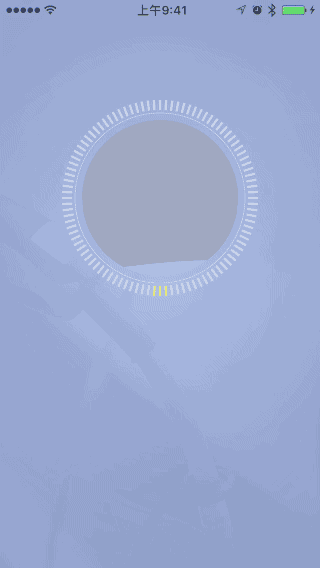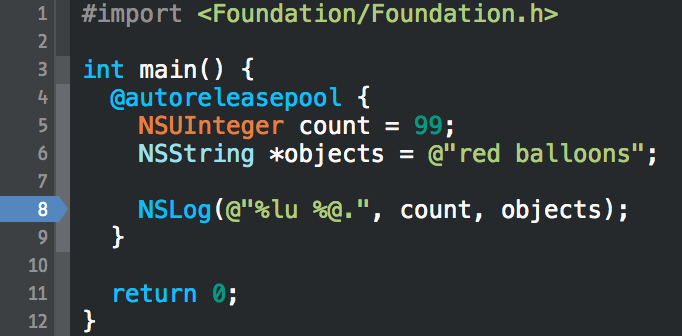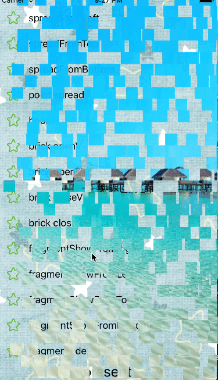iOS球形波浪加載進度控件-HcdProcessView詳解
《iOS球形波浪加載進度控件-HcdProcessView》這篇文章已經展示了我在項目中編寫的一個球形進度加載控件HcdProcessView,這篇文章我要簡單介紹一下我的制作過程。

思路
首先我放棄了使用通過改變圖片的位置來實現上面的動畫效果,雖然這樣也可以實現如上的效果,但是從性能和資源消耗上來說都不是最好的選擇。這裡我采用了通過上下文(也就是CGContextRef)來繪制這樣的效果,大家對它應該並不陌生,它既可以繪制直線、曲線、多邊形圓形以及各種各樣的幾何圖形。
具體步驟
我們可以將上面的復雜圖形拆分成如下幾步:
繪制最外面的一圈刻度尺
繪制表示進度的刻度尺
繪制中間的球形加載界面
繪制刻度尺
如果你先要在控件中繪制自己想要的圖形,你需要重寫UIView的drawRect方法:
- (void)drawRect:(CGRect)rect
{
CGContextRef context = UIGraphicsGetCurrentContext();
[self drawScale:context];
}在drawRect方法中,我們先畫出了刻度尺的圖形,刻度尺是由一圈短線在一個圓內圍成的一個圓。
/**
* 畫比例尺
*
* @param context 全局context
*/
- (void)drawScale:(CGContextRef)context {
CGContextSetLineWidth(context, _scaleDivisionsWidth);//線的寬度
//先將參照點移到控件中心
CGContextTranslateCTM(context, fullRect.size.width / 2, fullRect.size.width / 2);
//設置線的顏色
CGContextSetStrokeColorWithColor(context, [UIColor colorWithRed:0.655 green:0.710 blue:0.859 alpha:1.00].CGColor);//線框顏色
//繪制一些圖形
for (int i = 0; i < _scaleCount; i++) {
CGContextMoveToPoint(context, scaleRect.size.width/2 - _scaleDivisionsLength, 0);
CGContextAddLineToPoint(context, scaleRect.size.width/2, 0);
// CGContextScaleCTM(ctx, 0.5, 0.5);
//渲染
CGContextStrokePath(context);
CGContextRotateCTM(context, 2 * M_PI / _scaleCount);
}
//繪制刻度尺外的一個圈
CGContextSetStrokeColorWithColor(context, [UIColor colorWithRed:0.694 green:0.745 blue:0.867 alpha:1.00].CGColor);//線框顏色
CGContextSetLineWidth(context, 0.5);
CGContextAddArc (context, 0, 0, scaleRect.size.width/2 - _scaleDivisionsLength - 3, 0, M_PI* 2 , 0);
CGContextStrokePath(context);
//復原參照點
CGContextTranslateCTM(context, -fullRect.size.width / 2, -fullRect.size.width / 2);
}這裡需要用到兩個東西一個是CGContextAddArc,一個是CGContextAddLineToPoint。創建圓弧的方法有兩種一種是CGContextAddArc,一種是CGContextAddArcToPoint,這裡畫的圓比較簡單所以用的是CGContextAddArc,CGContextAddArcToPoint在後面也會用到(我會在用到的地方詳解)。
CGContextAddArc
void CGContextAddArc ( CGContextRef c, CGFloat x, //圓心的x坐標 CGFloat y, //圓心的x坐標 CGFloat radius, //圓的半徑 CGFloat startAngle, //開始弧度 CGFloat endAngle, //結束弧度 int clockwise //0表示順時針,1表示逆時針 );
這裡需要創建一個完整的圓,那麼 開始弧度就是0 結束弧度是 2PI, 因為圓周長是 2PIradius。函數執行完後,current point就被重置為(x,y)。CGContextTranslateCTM(context, fullRect.size.width / 2, fullRect.size.width / 2);已經將current point移動到了(fullRect.size.width / 2, fullRect.size.width / 2)。
CGContextAddLineToPoint
void CGContextAddLineToPoint ( CGContextRef c, CGFloat x, CGFloat y );
創建一條直線,從current point到 (x,y)
然後current point會變成(x,y)。
由於短線不連續,所以通過for循環來不斷畫短線,_scaleCount代表的是刻度尺的個數,每次循環先將current point移動到(scaleRect.size.width/2 - _scaleDivisionsLength, 0)點,_scaleDivisionsLength代表短線的長度。繪制完短線後將前面繪制完成的圖形旋轉一個刻度尺的角度CGContextRotateCTM(context, 2 * M_PI / _scaleCount);,將最終的繪制渲染後就得到了如下的刻度尺:

刻度尺上的進度繪制
首先在drawRect中添加drawProcessScale方法。
- (void)drawRect:(CGRect)rect
{ CGContextRef context = UIGraphicsGetCurrentContext();
[self drawScale:context];
[self drawProcessScale:context];
}然後在drawProcessScale方法中實現左右兩部分的刻度尺進度繪制。
/**
* 比例尺進度
*
* @param context 全局context
*/- (void)drawProcessScale:(CGContextRef)context {
CGContextSetLineWidth(context, _scaleDivisionsWidth);//線的寬度
CGContextTranslateCTM(context, fullRect.size.width / 2, fullRect.size.width / 2);
CGContextSetStrokeColorWithColor(context, [UIColor colorWithRed:0.969 green:0.937 blue:0.227 alpha:1.00].CGColor);//線框顏色
int count = (_scaleCount / 2 + 1) * currentPercent;
CGFloat scaleAngle = 2 * M_PI / _scaleCount; //繪制左邊刻度進度
for (int i = 0; i < count; i++) {
CGContextMoveToPoint(context, 0, scaleRect.size.width/2 - _scaleDivisionsLength);
CGContextAddLineToPoint(context, 0, scaleRect.size.width/2); // CGContextScaleCTM(ctx, 0.5, 0.5);
// 渲染
CGContextStrokePath(context);
CGContextRotateCTM(context, scaleAngle);
} //繪制右邊刻度進度
CGContextRotateCTM(context, -count * scaleAngle); for (int i = 0; i < count; i++) {
CGContextMoveToPoint(context, 0, scaleRect.size.width/2 - _scaleDivisionsLength);
CGContextAddLineToPoint(context, 0, scaleRect.size.width/2); // CGContextScaleCTM(ctx, 0.5, 0.5);
// 渲染
CGContextStrokePath(context);
CGContextRotateCTM(context, -scaleAngle);
}
CGContextTranslateCTM(context, -fullRect.size.width / 2, -fullRect.size.width / 2);
}繪制完後效果如下:

水的波浪效果繪制
終於到了最主要也是最難的效果繪制了,對於帶有波浪不斷滾動的效果是采用NSTimer來不斷繪制每一幀圖形實現的,現在簡單介紹下每一幀的繪制方法。
首先在drawRect中添加drawWave方法,
- (void)drawRect:(CGRect)rect
{ CGContextRef context = UIGraphicsGetCurrentContext();
[self drawScale:context];
[self drawProcessScale:context];
[self drawWave:context];
}drawWave中實現如下方法:
/**
* 畫波浪
*
* @param context 全局context
*/
- (void)drawWave:(CGContextRef)context {
CGMutablePathRef frontPath = CGPathCreateMutable();
CGMutablePathRef backPath = CGPathCreateMutable();
//畫水
CGContextSetLineWidth(context, 1);
CGContextSetFillColorWithColor(context, [_frontWaterColor CGColor]);
CGFloat offset = _scaleMargin + _waveMargin + _scaleDivisionsWidth;
float frontY = currentLinePointY;
float backY = currentLinePointY;
CGFloat radius = waveRect.size.width / 2;
CGPoint frontStartPoint = CGPointMake(offset, currentLinePointY + offset);
CGPoint frontEndPoint = CGPointMake(offset, currentLinePointY + offset);
CGPoint backStartPoint = CGPointMake(offset, currentLinePointY + offset);
CGPoint backEndPoint = CGPointMake(offset, currentLinePointY + offset);
for(float x = 0; x <= waveRect.size.width; x++){
//前浪繪制
frontY = a * sin( x / 180 * M_PI + 4 * b / M_PI ) * amplitude + currentLinePointY;
CGFloat frontCircleY = frontY;
if (currentLinePointY < radius) {
frontCircleY = radius - sqrt(pow(radius, 2) - pow((radius - x), 2));
if (frontY < frontCircleY) {
frontY = frontCircleY;
}
} else if (currentLinePointY > radius) {
frontCircleY = radius + sqrt(pow(radius, 2) - pow((radius - x), 2));
if (frontY > frontCircleY) {
frontY = frontCircleY;
}
}
if (fabs(0 - x) < 0.001) {
frontStartPoint = CGPointMake(x + offset, frontY + offset);
CGPathMoveToPoint(frontPath, NULL, frontStartPoint.x, frontStartPoint.y);
}
frontEndPoint = CGPointMake(x + offset, frontY + offset);
CGPathAddLineToPoint(frontPath, nil, frontEndPoint.x, frontEndPoint.y);
//後波浪繪制
backY = a * cos( x / 180 * M_PI + 3 * b / M_PI ) * amplitude + currentLinePointY;
CGFloat backCircleY = backY;
if (currentLinePointY < radius) {
backCircleY = radius - sqrt(pow(radius, 2) - pow((radius - x), 2));
if (backY < backCircleY) {
backY = backCircleY;
}
} else if (currentLinePointY > radius) {
backCircleY = radius + sqrt(pow(radius, 2) - pow((radius - x), 2));
if (backY > backCircleY) {
backY = backCircleY;
}
}
if (fabs(0 - x) < 0.001) {
backStartPoint = CGPointMake(x + offset, backY + offset);
CGPathMoveToPoint(backPath, NULL, backStartPoint.x, backStartPoint.y);
}
backEndPoint = CGPointMake(x + offset, backY + offset);
CGPathAddLineToPoint(backPath, nil, backEndPoint.x, backEndPoint.y);
}
CGPoint centerPoint = CGPointMake(fullRect.size.width / 2, fullRect.size.height / 2);
//繪制前浪圓弧
CGFloat frontStart = [self calculateRotateDegree:centerPoint point:frontStartPoint];
CGFloat frontEnd = [self calculateRotateDegree:centerPoint point:frontEndPoint];
CGPathAddArc(frontPath, nil, centerPoint.x, centerPoint.y, waveRect.size.width / 2, frontEnd, frontStart, 0);
CGContextAddPath(context, frontPath);
CGContextFillPath(context);
//推入
CGContextSaveGState(context);
CGContextDrawPath(context, kCGPathStroke);
CGPathRelease(frontPath);
//繪制後浪圓弧
CGFloat backStart = [self calculateRotateDegree:centerPoint point:backStartPoint];
CGFloat backEnd = [self calculateRotateDegree:centerPoint point:backEndPoint];
CGPathAddArc(backPath, nil, centerPoint.x, centerPoint.y, waveRect.size.width / 2, backEnd, backStart, 0);
CGContextSetFillColorWithColor(context, [_backWaterColor CGColor]);
CGContextAddPath(context, backPath);
CGContextFillPath(context);
//推入
CGContextSaveGState(context);
CGContextDrawPath(context, kCGPathStroke);
CGPathRelease(backPath);
}上面的代碼較長,可能也比較難以理解。下面我將會對上述代碼簡單解讀一下,已前浪為例(前浪和後浪的實現方式基本一樣,只是兩個浪正余弦函數不一樣而已)。兩個浪都是由一條曲線和和一個圓弧構成的封閉區間,曲線的x區間為[0, waveRect.size.width],y值坐標為frontY = a * sin( x / 180 * M_PI + 4 * b / M_PI ) * amplitude + currentLinePointY;(currentLinePointY為偏移量),通過for循環自增x,計算出y的位置來不斷CGPathAddLineToPoint繪制出一條曲線,這就構成了波浪的曲線。然後我們需要根據波浪曲線的起始點和結束點以及圓心點(fullRect.size.width / 2, fullRect.size.height / 2),來繪制一段封閉的圓弧。
這裡就需要用到CGPathAddArc方法;CGPathAddArc方法和CGContextAddArc類似。需要先計算出點波浪的起始點和結束點分別與圓心之間的夾角。知道兩點計算夾角的方式如下:
/**
* 根據圓心點和圓上一個點計算角度
*
* @param centerPoint 圓心點
* @param point 圓上的一個點
*
* @return 角度
*/
- (CGFloat)calculateRotateDegree:(CGPoint)centerPoint point:(CGPoint)point {
CGFloat rotateDegree = asin(fabs(point.y - centerPoint.y) / (sqrt(pow(point.x - centerPoint.x, 2) + pow(point.y - centerPoint.y, 2))));
//如果point縱坐標大於原點centerPoint縱坐標(在第一和第二象限)
if (point.y > centerPoint.y) {
//第一象限
if (point.x >= centerPoint.x) {
rotateDegree = rotateDegree;
}
//第二象限
else {
rotateDegree = M_PI - rotateDegree;
}
} else //第三和第四象限
{
if (point.x <= centerPoint.x) //第三象限,不做任何處理
{
rotateDegree = M_PI + rotateDegree;
}
else //第四象限
{
rotateDegree = 2 * M_PI - rotateDegree;
}
}
return rotateDegree;
}波浪繪制的相關判斷
由於曲線x區間是[0, waveRect.size.width],y值是根據公式frontY = a * sin( x / 180 * M_PI + 4 * b / M_PI ) * amplitude + currentLinePointY;計算出來的,但是最終構成的波浪是一個球形的,所以對於計算出來的y值坐標,我們需要判斷它是否在圓上,如果不在圓上,我們應該將它移到圓上。
判斷分為兩種情況:
currentLinePointY當currentLinePointYy1 = a * sin( x / 180 * M_PI + 4 * b / M_PI ) * amplitude + currentLinePointY;算出來的點位置為(x, y1),而在圓上點坐標為x的點的位置在(x,y2),如果y1(x,y2)。

currentLinePointY>fullRect.size.height / 2
同理當currentLinePointY>fullRect.size.height / 2時,已知點的坐標x,根據公式y1 = a * sin( x / 180 * M_PI + 4 * b / M_PI ) * amplitude + currentLinePointY;算出來的點位置為(x, y1),而在圓上點坐標為x的點的位置在(x,y2),如果y1>y2 則最終應該放到波浪上的點為 (x,y2)。

其中判斷的代碼如下:
frontY = a * sin( x / 180 * M_PI + 4 * b / M_PI ) * amplitude + currentLinePointY;
CGFloat frontCircleY = frontY;
if (currentLinePointY < radius) {
frontCircleY = radius - sqrt(pow(radius, 2) - pow((radius - x), 2));
if (frontY < frontCircleY) {
frontY = frontCircleY;
}
} else if (currentLinePointY > radius) {
frontCircleY = radius + sqrt(pow(radius, 2) - pow((radius - x), 2));
if (frontY > frontCircleY) {
frontY = frontCircleY;
}
}其中當currentLinePointY < radius時,y2=radius - sqrt(pow(radius, 2) - pow((radius - x), 2));
當currentLinePointY > radius時,y2=radius + sqrt(pow(radius, 2) - pow((radius - x), 2));
這樣就構成了一個如下的效果:

然後通過Timer不斷的改變a、b的值就得到了我想要的動畫效果。
Github地址:https://github.com/Jvaeyhcd/HcdProcessView
文章轉自 Jvaeyhcd的簡書
當currentLinePointY

currentLinePointY>fullRect.size.height / 2
同理當currentLinePointY>fullRect.size.height / 2時,已知點的坐標x,根據公式y1 = a * sin( x / 180 * M_PI + 4 * b / M_PI ) * amplitude + currentLinePointY;算出來的點位置為(x, y1),而在圓上點坐標為x的點的位置在(x,y2),如果y1>y2 則最終應該放到波浪上的點為 (x,y2)。

其中判斷的代碼如下:
frontY = a * sin( x / 180 * M_PI + 4 * b / M_PI ) * amplitude + currentLinePointY;
CGFloat frontCircleY = frontY;
if (currentLinePointY < radius) {
frontCircleY = radius - sqrt(pow(radius, 2) - pow((radius - x), 2));
if (frontY < frontCircleY) {
frontY = frontCircleY;
}
} else if (currentLinePointY > radius) {
frontCircleY = radius + sqrt(pow(radius, 2) - pow((radius - x), 2));
if (frontY > frontCircleY) {
frontY = frontCircleY;
}
}其中當currentLinePointY < radius時,y2=radius - sqrt(pow(radius, 2) - pow((radius - x), 2));
當currentLinePointY > radius時,y2=radius + sqrt(pow(radius, 2) - pow((radius - x), 2));
這樣就構成了一個如下的效果:

然後通過Timer不斷的改變a、b的值就得到了我想要的動畫效果。
Github地址:https://github.com/Jvaeyhcd/HcdProcessView
- 上一頁:Xcode8
- 下一頁:Xcode7升級到Xcode8之後遇到文件沖突




